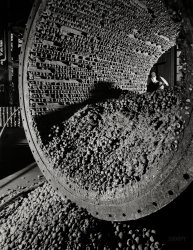
MAY CONTAIN NUTS

Search Shorpy
SHORPY ART

Framed or unframed, desk size to sofa size, printed by us in Arizona and Alabama since 2007. Explore now.
Join and Share
Ad-Free Shorpy
Shorpy is funded by you. Patreon contributors get an ad-free experience.
Learn more.

Recent comments
- A Beautiful Moment
- Such joy
- Bethune-Cookman University today...
- Yellow sky at morning
- Side Winder
- Air Quality?
- Sojourner Truth riot
- None were so blind(ed)
- The less famous sister
- Good ol' days?
- Rise and Fall
- Goo Goo Ga Joob
- Ticket Retention
- Not the only one
- Vagaries of War
- Killed by Amtrak
- Back to the Future
- Wanted --
- If you can't stand the light
- Centralized Traffic Control, I believe
- What's really happening
- Heckuva remote control!
- Sometimes — Things Go Bump!
- I SEE THE LIGHT
- Union Switch and Signal Company
- Get That Light Out Of My Eyes
- Eggs. Eggs. Eggs. The Egg Man is Here!
- Foreboding caption
- Famous Hollywood faces
- Not just S&P
Member Photos
The Shorpy
Print Emporium
Print Emporium
Search Shorpy
Search results -- 30 results per page
- Handsome Hoya: 1925
- ... 6'4" to 6'8" and about 290-350 lbs. An offensive guard (interior lineman) will range from about 6'0" to 6'5" and about 280-330 lbs. A ... Posted by Dave - 08/27/2012 - 12:10pm -
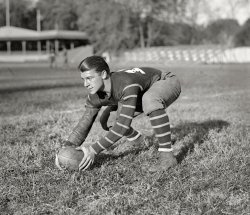
- Plunge Bathers: 1891
- 1891. "Hot Springs, South Dakota. Interior of largest plunge bath in U.S. on Fremont, Elkhorn & Missouri ... Posted by Dave - 09/07/2013 - 10:13am -
![Plunge Bathers: 1891 1891. "Hot Springs, South Dakota. Interior of largest plunge bath in U.S. on Fremont, Elkhorn & Missouri Valley Railway." Photo by John C.H. Grabill, noted chronicler of the Western frontier and "Official Photographer of the Black Hills and Fort Pierre R.R. & Home Stake Mining Co. -- Studios: Deadwood and Lead City, S.D. -- A Handsome Reward given for detection of any one copying any of my Photographic Views." View full size.
Evans PlungeI live in SD and went to Evans Plunge as a child. It's now owned by the city of Hot Springs.
Plunge?This term was apparently common in the 19th and early 20th centuries but what makes a "plunge" different than a swimming pool? Why the different term?
[Because these pools were more for bathing as opposed to swimming. - Dave]
Brass BandsI sincerely miss those brass bands that used to play at the pool in the summer.
(The Gallery, Frontier Life, John Grabill, Swimming)](https://www.shorpy.com/files/images/SHORPY_02577u.thumbnail.jpg)
- Payson Place: 1940
- ... Moderne.
Any more like this? I'd love to see the interior of this grand house.
[ Click here for more. -Dave]
... Posted by Dave - 03/19/2019 - 12:35pm -
![Payson Place: 1940 January 13, 1940. "Charles S. Payson residence in Hobe Sound, Florida. Entrance facade, horizontal, windows closed. Beatrice Stewart Inc., decorator. Treanor & Fatio, architect." 5x7 acetate negative by Gottscho-Schleisner. View full size.
Modern TimesWhat a great example of mid-40's modern movement that house is.
We forget that besides the hotels in South Beach and other areas of Florida, there are many excellent examples of these homes throughout the state, usually with concrete block construction and covered in cement stucco. Termite, fire, and (pretty near) storm-proof.
I note the insets and designs on the facade walls to keep it from being blank and boring, the second-floor balcony permitted by the design's flat roofs, and the fireplace chimney, probably the only source of heat in the whole house for those occasional frosty Florida mornings.
The price for a waterfront property like that would be in the millions today; due in part, no doubt, to the architecture. This picture is a keeper.
TransitionalThis is a VERY interesting architect-designed structure, sitting pretty much on the border between late Art Deco and Art Moderne. Give it a few more rounded corners, and it'd be right on the pig's back in Streamline Moderne.
Any more like this?I'd love to see the interior of this grand house.
[Click here for more. -Dave]
Let’s Go MetsMrs. Charles S. Payson (Joan) was the original principal owner of the New York Mets.
(The Gallery, Florida, Gottscho-Schleisner)](https://www.shorpy.com/files/images/SHORPY-5a04461u.thumbnail.jpg)
- Gaslight: 1909
- ... size.
Gaslight Cool! I've never seen a pic with interior gas lights. Great site!
(The Gallery, Boston, Kids, Lewis Hine) ... Posted by Dave - 08/15/2012 - 8:45am -
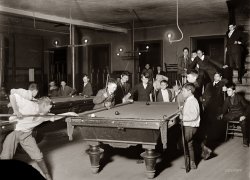
- Splane House: 1938
- ... Grand Old House This listing detail has a number of interior pictures and it appears beautifully restored. The living spaces seem ... Posted by Dave - 09/17/2017 - 9:30am -
![Splane House: 1938 1938. "Splane House at Arlington Plantation. Washington, St. Landry Parish, Louisiana. Built 1829 by Major Amos Webb; purchased ca. 1870 by the Misses Splane." 8x10 acetate negative by Frances Benjamin Johnston. View full size.
Looking a bit better these daysThis house is located at 386 Arlington Road northwest of Washington, LA. It and its 1.73 acres were offered for sale earlier this year at just under $500K. There were apparently no takers.
The fence.I wonder how long it took to make all those pickets for that fence.
[Not long, and at a machinery-equipped mill or factory. -tterrace]
Grand Old HouseThis listing detail has a number of interior pictures and it appears beautifully restored. The living spaces seem quite grand and the grounds seem very well-kept. The upkeep would be daunting no doubt. I would need to change the wallpaper in the bathrooms though.
(The Gallery, F.B. Johnston)](https://www.shorpy.com/files/images/SHORPY-01590a.thumbnail.jpg)
- Cruising: 1925
- ... would be the optimal. This included the mechanicals, interior and finish.
All of these early teens, twenties, early thirties ... Posted by Dave - 10/05/2016 - 5:32pm -
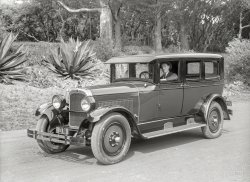
- Joy Ride: 1920
- ... illustrated dailies and Sunday supplements. One of the interior shots shows her studying a piece of sheet music, and another shows her ... Posted by Dave - 09/12/2011 - 12:07pm -
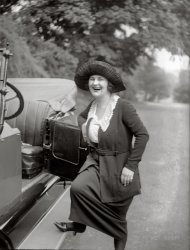
- The Invisible Hand: 1942
- ... the outside, fastened with that same wire, created a flat interior surface over which food could slide smoothly onto a plate.
New ... Posted by Dave - 02/11/2017 - 8:26am -
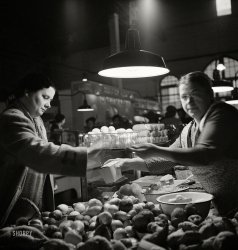
- Ford Parts: 1920
- ... 1920. "Taylor-Tolley Motor Co., authorized Ford agents, interior." National Photo Company Collection glass negative. View full size. ... Posted by Dave - 03/12/2018 - 10:32am -
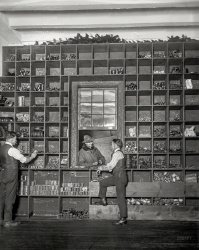
- Smokestack Washington: 1921
- ... N.W., but was it from the roof of the Department of the Interior or a building that preceded it??
This photo looks to the east. ... Posted by Dave - 09/12/2011 - 2:34pm -
![Smokestack Washington: 1921 Washington, D.C., circa 1921. "Aerial view looking toward Capitol and Washington Monument." National Photo Company Collection glass negative. View full size.
An Eclipse of the EllipseWhat puzzles me is the photographer's vantage point. No doubt it was from the corner of 18th and E Streets N.W., but was it from the roof of the Department of the Interior or a building that preceded it??
This photo looks to the east. The white building to the left is the headquarters of the American Red Cross. It's still there, but gone is the less-ornate wing to the right with its smokestack. I believe that building was one of the infamous "temporary" office buildings of First World War vintage that were ubiquitous features of DC landscape up until the late 1960s. The neighbor to the right is DAR Constitution Hall, which remains remarkably unchanged to this day. Across the street, of course, is the Ellipse, which you can think of as the "backyard" of the White House. Beyond the Ellipse are landmarks that need no introduction (the Washington Monument, the Old Post Office, the Capitol, Bureau of Engraving, etc.) Perhaps another reader can verify that the two smokestacks just left of center belong to a Pepco generator that powered street cars. Despite the haze, one can faintly see the arched roof of Union Station, appearing on the horizon to the far left.
[There was a tall brick building behind Red Cross HQ. Click below to enlarge. - Dave]
Ordnance OfficeBased on the bit of the 1919-1921 Baist Realty map below (click on it for a larger version), I would guess the photographer was on top of the Ordnance Office of the War Department. It is puzzling that the angle of the photo does suggest quite an elevation and the ordnance office doesn't appear to be a large building: perhaps there was some sort of observation tower on top of the building.
The smokestacks in the distance are indeed the Potomac Electric Power Co. Plant at northeast corner of 14th &B streets N.W.: they are also visible in the background of this Shorpy photo.
Also indicated on the map is the Frazee Potomac Laundry, seen here.
(The Gallery, D.C., Natl Photo)](https://www.shorpy.com/files/images/30461u2.thumbnail.jpg)
- Pontoons on the Potomac: 1925
- ... in a theatre where Mr. Keith is in authority."
Nice interior pictures here:
... Posted by Dave - 11/28/2016 - 7:48pm -
![Pontoons on the Potomac: 1925 April 29, 1925. "Girls from Keith's [vaudeville theater] at Arlington Beach." National Photo Company Collection glass negative. View full size.
Keith's was Polite and High Class B.F. Keith was the reigning king of vaudeville in the eastern U.S. in the 20s operating some 30 different theaters and having an estimated net worth of $50 million. Keith had begun in Boston offering only clean entertainment that would appeal to middle-class sensibilities and eschewing the bawdiness of burlesque houses. With the help of his ruthless manager E.F. Albee, he became wildly successful. His theaters all reportedly posted backstage the following warning for performers:
"Don't say ‘slob’ or ‘son of a gun’ or ‘hully gee’ on the stage unless you want to be canceled peremptorily. Do not address anyone in the audience in any manner. If you do not have the ability to entertain Mr. Keith's audience without risk of offending them, do the best you can. Lack of talent will be less open to censure than would be an insult to a patron. If you are in doubt as to the character of your act consult the local manager before you go on stage, for if you are guilty of uttering anything sacrilegious or even suggestive you will be immediately closed and will never again be allowed in a theatre where Mr. Keith is in authority."
Nice interior pictures here:
http://www.streetsofwashington.com/2010/05/vaudeville-and-other-high-dra...
Familiar facesWe've seen these ladies before.
(The Gallery, D.C., Natl Photo, Pretty Girls, Swimming)](https://www.shorpy.com/files/images/SHORPY-13455u.thumbnail.jpg)
- Independence Day: 1941
- ... on his left. Dad had recently returned to the Zone of the Interior from a nearly four-year post to Schofield Barracks, Territory of ... Posted by Zeke - 04/28/2010 - 2:38pm -

- Imposing Repository: 1905
- ... those who debate with spray paint.
Fortunately, the interior was spared, including the courtyard (below) that was modeled after the ... Posted by Dave - 07/21/2020 - 5:54pm -
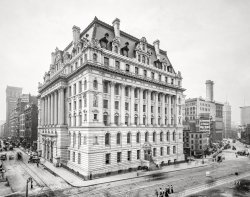
- Desert Trip
- ... tone I checked with my 83 yr old mom, and she said the interior was in black and white vinyl.
Thanks for your comment and your ... Posted by Mvsman - 09/18/2011 - 11:16pm -
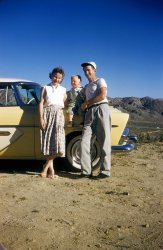
- Hotel Seneca: 1908
- ... Rochester, New York, circa 1908. "Hotel Seneca." The interior seen earlier here . 8x10 inch dry plate glass negative, Detroit ... Posted by Dave - 01/11/2013 - 9:16am -

- Modern Amoeba: 1947
- ... business on Main Street in Paterson, New Jersey. Interior, to rear." Witness to one of midcentury design's favorite mashups, the ... Posted by Dave - 02/23/2015 - 10:16pm -
![Modern Amoeba: 1947 Jan. 27, 1947. "Kartch's, business on Main Street in Paterson, New Jersey. Interior, to rear." Witness to one of midcentury design's favorite mashups, the trapezoid and the amoeba. Large-format negative by Gottscho-Schleisner. View full size.
And AtomsSkewered on the left there. Never tired of little round atoms in those days.
Ah! Space To Move AroundLooks like the children's department, with jackets for the boys, dresses for the girls, and some stuffed toys to play with.
But what impresses me the most is the SPACE the store has allocated for the customer to move around in while perusing their selections. I remember stores like this that my mom took me to in the early 50's; getting a new suit for Easter in stores like Robert Hall, Gertz, Alexanders etc. in Queens County.
Today's stores jam stuff in every available inch of space, and you can't even browse without jostling other customers. If I found a store like this today, I would be a regular.
TrapezoidActually a good design as it maximizes floor space under the hanging clothing. My ponderment is this - WHAT was the sitting area required for in a childrens department?? Did the store sponsor some sort of employee's child after school? Chair, lighted desk area, etc.
[Presumably for more comfortable perusing of smaller items. -tterrace]
(The Gallery, Gottscho-Schleisner, Stores & Markets)](https://www.shorpy.com/files/images/SHORPY-5a13593u.thumbnail.jpg)
- Shadow Government: 1908
- ... completed. Remaining work, including restoration of the interior face, is awaiting approval of funds.
(The Gallery, D.C., DPC) ... Posted by Dave - 07/31/2013 - 12:10pm -
![Shadow Government: 1908 Circa 1908. "West front, U.S. Capitol, Washington." Today only, a tricameral legislature. 8x10 glass negative, Detroit Publishing Co. View full size.
1908 mowingWhenever I see large fields of manicured grass in these old photos I wonder how were these fields were kept mowed before the era of modern mowing tractors? Anybody know?
[Horse-drawn mowers, such as this from around the same time. -tterrace]
Hey that's pretty clever- they mow and fertilize at the same time! ;-)
Re: Mower... with automatic fertilizer and spreader!
Not white?The dome and even the main buildings don't look as white as they are today. I always thought it was the natural color of the stone that made it white. Did they start white-washing it later?
The US Capitol dome is paintedIt's not constructed of stone at all, but of nearly 9 million pounds of cast iron. The exterior has to be repainted occasionally. That last occurred in 2010 when more than 500 gallons of paint was applied. A more comprehensive phased restoration project was initiated in 2012 that involves removal of all paint from the dome, repairing defects in the ironwork, resealing, and finally repainting with an epoxy and urethane paint system. The skirt portion of the dome has been completed. Remaining work, including restoration of the interior face, is awaiting approval of funds.
(The Gallery, D.C., DPC)](https://www.shorpy.com/files/images/SHORPY_4a20003a.thumbnail.jpg)
- Produce Exchange: 1904
- ... all load-bearing brick; it was the "window walls" of the interior light court that sat in the center of the top four floors (above the ... Posted by Dave - 08/22/2014 - 11:07am -
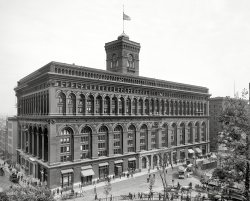
- Big Dipper: 1906
- Circa 1906. "Interior, High Rock Spring, Saratoga, N.Y.," a.k.a. the "Medicine Spring of the ... Posted by Dave - 06/04/2020 - 6:46pm -
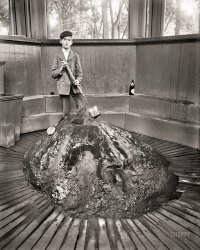
- City Hell: 1906
- ... ruins. The structure wasn't seriously damaged, but the interior was gutted by the fire. -tterrace]
Like Greek ruins Really ... Posted by Dave - 04/21/2018 - 6:36pm -
![City Hell: 1906 "Ruins of San Francisco City Hall following earthquake and fire of April 1906." 8x10 inch dry plate glass negative, Detroit Publishing Company. View full size.
Salty sandOne of the reasons the building was so badly damaged was that though he was paid for inland sand the contractor used beach sand which was still quite salty. When the heat of the fire and the water from the firefighters' hoses combined the salt expanded and the mortar between the bricks exploded. The domed building behind it on the left was the Annex which contained all the building records and to this day it is impossible to figure an exact date of anything constructed before 1906.
[The Hall of Records is partly visible behind the rightmost edge of the City Hall ruins. The structure wasn't seriously damaged, but the interior was gutted by the fire. -tterrace]
Like Greek ruinsReally interesting that a thousands year old architectural design is one of the few things still standing, the Corinthian columns still supporting the beam and the cornice.
(The Gallery, DPC, Fires, Floods etc., San Francisco)](https://www.shorpy.com/files/images/SHORPY-4a25729a.thumbnail.jpg)
- Hagyard's: 1911
- ...
I like that building More pictures of the interior and exterior can be found here .
(The Gallery, DPC, Stores & ... Posted by Dave - 10/16/2019 - 4:37pm -
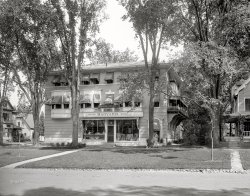
- Old, Old Glory: 1865
- 1865. Vicinity of Charleston, South Carolina. Interior view of Fort Johnson on Morris Island. View full size. Half of a ... Posted by Dave - 09/01/2011 - 7:13am -
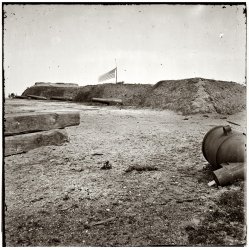
- The Final Cut: 1960
- December 1960. "Interior, barber shop. Republic Building, 209 South State Street, Chicago. ... Posted by Dave - 09/25/2016 - 7:48pm -
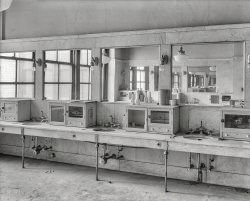
- Club Coupe: 1920
- ... the drool all over my keyboard.
Knee to knee If the interior follows the "opera coupé" configuration, then it's driver and one ... Posted by Dave - 06/09/2017 - 10:12am -
![Club Coupe: 1920 San Francisco circa 1920. "Mercer four-passenger coupe." At the vine-covered California Club. 5x7 glass negative by Christopher Helin. View full size.
Yum, Yum.Famous for the Raceabout model we rarely see the other Mercers. This car is so cool that I could eat it with a spoon. Please excuse the drool all over my keyboard.
Knee to kneeIf the interior follows the "opera coupé" configuration, then it's driver and one passenger in front, and two in the rear on jump seats, facing each other rather than forward.
A chauffeur-driven variant had a full (and often sumptuous) conventional rear seat, a less commodious front passenger seat that folded completely forward to facilitate access to the rear seat, and a driver's seat mounted further forward than in the opera coupé in order to maximize rear-seat leg room.
The chauffeur of the latter had little cause for complaint, cramped driving position or not. At least he was out of the weather, unlike his colleagues piloting open-cockpit town cars.
[The photo shows a full-width, forward-facing back seat. - Dave]
1750 Clay StreetMuch altered, but still recognizably the same building. They even kept the same awning.
(The Gallery, Cars, Trucks, Buses, Chris Helin, San Francisco)](https://www.shorpy.com/files/images/SHORPY-1183.thumbnail.jpg)
- Union Depot: 1905
- ... roof for ice. Insulated boxcars have the same doors and interior insulation as reefers, but don't need the ice. They keep the beer ... Posted by Dave - 04/17/2018 - 11:54am -
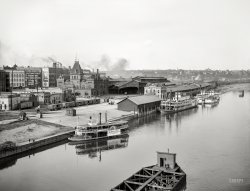
- Executive Patio: 1953
- ... "Becton Dickinson & Co., East Rutherford, New Jersey. Interior from entrance to rear reception room. Fellheimer & Wagner, ... Posted by Dave - 11/10/2016 - 2:45pm -
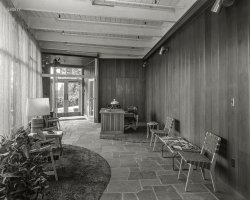
- Briques de Dubuque: 1940
- ... can stay here The Redstone Inn and Suites with vintage interior: http://www.theredstoneinn.com/
For sale Listed at ... Posted by Dave - 04/19/2020 - 4:05pm -
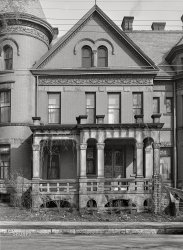
- Orts Expo: 1950
- ... Mass.
Eastern States Exposition This is an interior shot of the Massachusetts Building at the Eastern States Exposition, ... Posted by John.Debold - 07/07/2015 - 1:04pm -
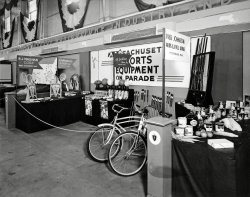
- Chez Cerises: 1940
- July 1940. "Interior of one-room cabin occupied by migrant fruit pickers and packinghouse ... Posted by Dave - 12/10/2019 - 9:14pm -
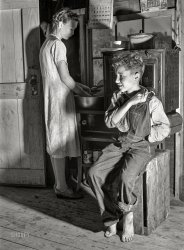
- Balls of Iron: 1942
- November 1942. "Production. Copper. Interior of large ball mill showing the iron balls which grind the ore to a ... Posted by Dave - 09/09/2017 - 6:25am -
